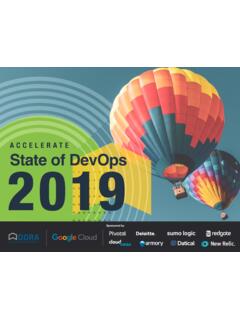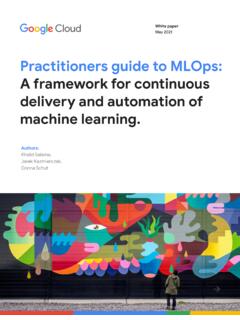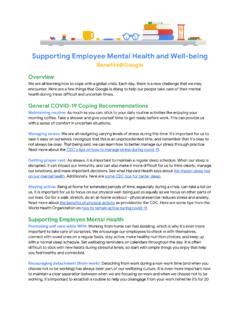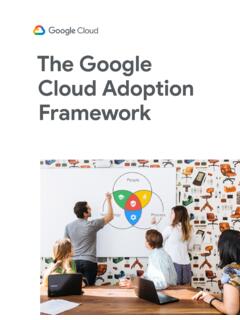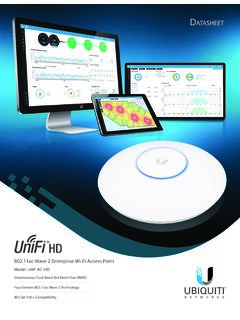Transcription of Accelerate State of DevOps 2021
1 Accelerate State of DevOps 2021. Sponsored by Table of contents Chapter 1. Executive summary Key findings 06. Chapter 2. How do we compare? Software delivery and operational performance 09. Chapter 3. How do we improve? Cloud 15 Security 24. SRE and DevOps 19 Technical DevOps capabilities 26. Documentation 21 COVID-19 29. Culture 31. 2. Table of contents Chapter 4. Who took the survey? Demographics and firmographics 34. Chapter 5. Final thoughts Chapter 6. Acknowledgements Chapter 7. Authors Chapter 8. Methodology Chapter 9. Further reading 3. Accelerate State of DevOps 2021. Chapter 1. Executive summary This year's Accelerate State of DevOps Report by the DevOps Research and Assessment (DORA). team at Google Cloud represents seven years of research and data from more than 32,000. professionals worldwide. Our research examines the capabilities and practices that drive software delivery, operational, and organizational performance .
2 By leveraging rigorous statistical techniques, we seek to understand the practices that lead to excellence in technology delivery and to powerful business outcomes. To this end, we present data-driven insights about the most effective and efficient ways to develop and deliver technology. Executive summary | 4. Accelerate State of DevOps 2021. Our research continues to show that excellence in software delivery and operational performance drives organizational performance in technology transformations. To allow teams to benchmark themselves against the industry, we use a cluster analysis to form meaningful performance categories (such as low, medium, high, or elite performers). After your teams have a sense of their current performance relative to the industry, you can use the findings from our predictive analysis to target practices and capabilities to improve key outcomes, and eventually your relative position.
3 This year we emphasize the importance of meeting reliability targets, integrating security throughout the software supply chain, creating quality internal documentation, and leveraging the cloud to its fullest potential. We also explore whether a positive team culture can mitigate the effects of working remotely as a result of the COVID-19 pandemic. To make meaningful improvements, teams must adopt a philosophy of continuous improvement. Use the benchmarks to measure your current State , identify constraints based on the capabilities investigated by the research, and experiment with improvements to relieve those constraints. Experimentation will involve a mix of victories and failures, but in both scenarios teams can take meaningful actions as a result of lessons learned. Executive summary | 5. Accelerate State of DevOps 2021. Key findings 01 The highest performers are growing and continue to raise the bar.
4 Elite performers now make up 26% of teams in our study, and have decreased their lead times for changes to production. The industry continues to Accelerate , and teams see meaningful benefits from doing so. 02 SRE and DevOps are complementary philosophies. Teams that leverage modern operational practices outlined by our Site Reliability Engineering (SRE) friends report higher operational performance . Teams that prioritize both delivery and operational excellence report the highest organizational performance . 03 More teams are leveraging the cloud and see significant benefits from doing so. Teams continue to move workloads to the cloud and those that leverage all five capabilities of cloud see increases in software delivery and operational (SDO) performance , and in organizational performance . Multi-cloud adoption is also on the rise so that teams can leverage the unique capabilities of each provider.
5 Executive summary | 6. Accelerate State of DevOps 2021. 04 A secure software supply chain is both essential and drives performance . Given the significant increase in malicious attacks in recent years, organizations must shift from reactive practices to proactive and diagnostic measures. Teams that integrate security practices throughout their software supply chain deliver software quickly, reliably, and safely. 05 Good documentation is foundational for successfully implementing DevOps capabilities. For the first time, we measured the quality of internal documentation and practices that contribute to this quality. Teams with high quality documentation are better able to implement technical practices and perform better as a whole. 06 A positive team culture mitigates burnout during challenging circumstances. Team culture makes a large difference to a team's ability to deliver software and meet or exceed their organizational goals.
6 Inclusive teams with a generative1,2 culture experienced less burnout during the COVID-19 pandemic. 1 From Westrum's typology organization culture, a generative team culture refers to teams that are highly cooperative, break down silos, let failure lead to inquiry, and share the risk of decision making. 2 Westrum, R. (2004). A typology of organizational cultures. BMJ Quality & Safety, 13(suppl 2), ii22-ii27. Executive summary | 7. Accelerate State of DevOps 2021. Chapter 2. How do we compare? Are you curious about how your team compares to others in the industry? This section includes the latest benchmark assessment of DevOps performance . We examine how teams develop, deliver, and operate software systems, and then segment respondents into four performance clusters: elite, high, medium, and low performers. By comparing your team's performance to the performance of each cluster, you can see where you are in the context of the findings described throughout this report.
7 How do we compare? | 8. Accelerate State of DevOps 2021. Software delivery and operational performance To meet the demands of an ever-changing industry, Teams that excel in all five measures exhibit organizations must deliver and operate software exceptional organizational performance . quickly and reliably. The faster your teams can make We call these five measures software delivery changes to your software, the sooner you can and operational (SDO) performance . Note that deliver value to your customers, run experiments, these metrics focus on system-level outcomes, and receive valuable feedback. With seven years which helps avoid the common pitfalls of software of data collection and research, we have developed metrics, such as pitting functions against each and validated four metrics that measure software other and making local optimizations at the cost delivery performance . Since 2018, we've included of overall outcomes.
8 A fifth metric to capture operational capabilities. Software delivery performance metric Elite High Medium Low Deployment frequency On-demand Between once Between once Fewer than (multiple deploys per week and per month and once per For the primary application or service you work on, how per day) once per month once every six months often does your organization deploy code to production 6 months or release it to end users? Lead time for changes Less than Between Between one More than one hour one day and month and six months For the primary application or service you work on, what one week six months is your lead time for changes ( , how long does it take to go from code committed to code successfully running in production)? Time to restore service Less than Less than Between More than one hour one day one day and six months For the primary application or service you work on, how one week long does it generally take to restore service when a service incident or a defect that impacts users occurs ( , unplanned outage or service impairment)?
9 Change failure rate 0%-15% 16%-30% 16%-30% 16%-30%. For the primary application or service you work on, what percentage of changes to production or released to users result in degraded service ( , lead to service impairment or service outage) and subsequently require remediation ( , require a hotfix, rollback, fix forward, patch)? How do we compare? | 9. Accelerate State of DevOps 2021. Four metrics of The fifth metric: delivery performance from availability to reliability The four metrics of software delivery performance The fifth metric represents operational performance can be considered in terms of throughput and and is a measure of modern operational practices. stability. We measure throughput using lead time The primary metric for operational performance is of code changes (that is, time from code commit reliability, which is the degree to which a team can to release in production), and deployment keep promises and assertions about the software frequency.
10 We measure stability using time to they operate. Historically we have measured availability restore a service after an incident and change rather than reliability, but because availability is failure rate. a specific focus of reliability engineering, we've expanded our measure to reliability so that availability, Once again, cluster analysis of the four software latency, performance , and scalability are more broadly delivery metrics reveals four distinct performance represented. Specifically, we asked respondents to profiles elite, high, medium, and low with statistically rate their ability to meet or exceed their reliability significant differences in throughput and stability targets. We found that teams with varying degrees measures among them. As in previous years, our of delivery performance see better outcomes when highest performers do significantly better on all four they also prioritize operational performance .
